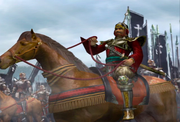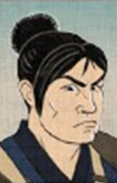
Yoshihiro Shimazu in 1600.

Yoshihiro Shimazu at Iwaya Castle.
Yoshihiro Shimazu (1535-1619) was a daimyo from Satsuma Province, ruling the Shimazu clan. He was most famous for his attack on Fushimi Castle after Mototada Torii refused to allow him to join the Eastern Army.
Biography[]

Yoshihiro Shimazu at the age of fourteen.
Yoshihiro Shimazu was the second son of Takahisa Shimazu, a warlord from Kyushu. Yoshihiro was the younger brother of Yoshihisa Shimazu and the older brother of Toshihisa Shimazu and Iehisa Shimazu. Yoshihiro became a military commander in 1549 at the age of fourteen, after being designated heir, as he came of age earlier than Yoshihisa. Yoshihiro's first campaigns were against the Mori, assisting his father in his fighting against Motonari Mori. After fighting across Honshu against dozens of clans, including the Amako and Takaoka.
After a long time of campaigning, he grew a talent for being ruthless, and proved to be a cold-hearted daimyo when his father died. In the 1580s, he fought against the Otomo and Tachibana of Kyushu, who gained independent status from the Shimazu after Takahisa's death. Yoshihiro struck down the Otomo general, Joun Takahashi and all but defeated the Tachibana, but in 1586, the Toyotomi clan, who were in the process of uniting Japan, invaded Kyushu to rescue their Tachibana vassals. They defeated Yoshihiro and Yoshihisa in battle, and Yoshihiro became a Toyotomi vassal as well.

Coat-of-arms of Yoshihiro Shimazu, at times incorrectly represented as a Christian cross.
In 1590, he took part in the Fall of Odawara, where Hideyoshi Hashiba gathered a coalition of his vassals to finally defeat the Hojo clan, the last link in the chain that led to unification. Yoshihiro fought alongside his nemeses, the Tachibana, and fought alongside all of Japan's samurai warriors. He served in Hideyoshi's invasions of Korea from 1592 to 1598, and returned home to Kyushu after the death of Hideyoshi, which signalled the end of the war in Korea and the unification of Japan. By 1600, the scrapping over provinces became a succession crisis split between Hideyoshi's former general Mitsunari Ishida and the most powerful warlord in all Japan, Ieyasu Tokugawa. Yoshihiro was initially partial to the Eastern Army, Tokugawa's cause, because he was unfriendly with Mitsunari, who was arrogant and refused to concede when he was wrong. Yoshihiro was refused entry into Fushimi Castle by the Tokugawa lord Mototada Torii, and, now facing the besieging Western Army, joined them. Coincidentally, they were led by the Tachibana. However, they fought as a formidable team and Mototada committed seppuku rather than concede defeat.
Yoshihiro and the Tachibana, now close allies, also attacked Otsu Castle, held by Takatsugu Kyogoku. Motoyasu Mori assisted Yoshihiro and his allies in the capture of the castle, repelling reinforcements by Tadakatsu Honda. The trio later returned to Kyushu to defend it from Kanbei Kuroda, the valuable strategist of the Eastern Army. At the Ishigaki Plains, the Eastern Army and Western Army fought to a bloody standstill that ended with a Western Army surrender, but only after news arrived that the Battle of Sekigahara was lost. Yoshihisa Shimazu did not even aid the Western Army in Sekigahara, standing still with his forces after being insulted by Mitsunari's messenger, who did not dismount his horse to bring a message to the Shimazu.
Yoshihiro lived in peace in Kyushu, living until he was at a ripe old age and died. He was 84 years old when he died.





